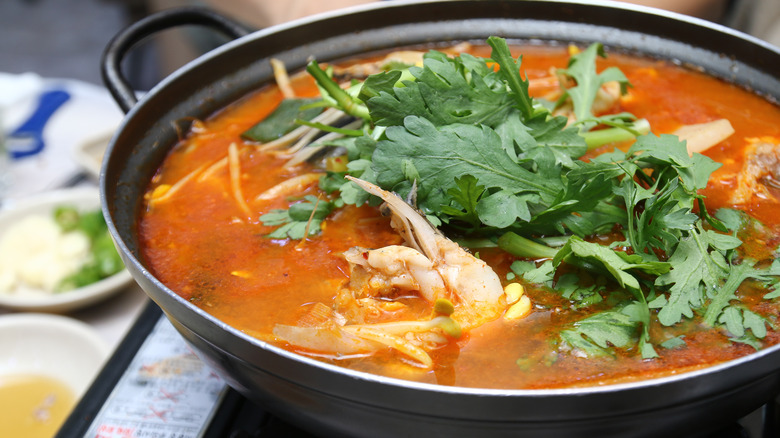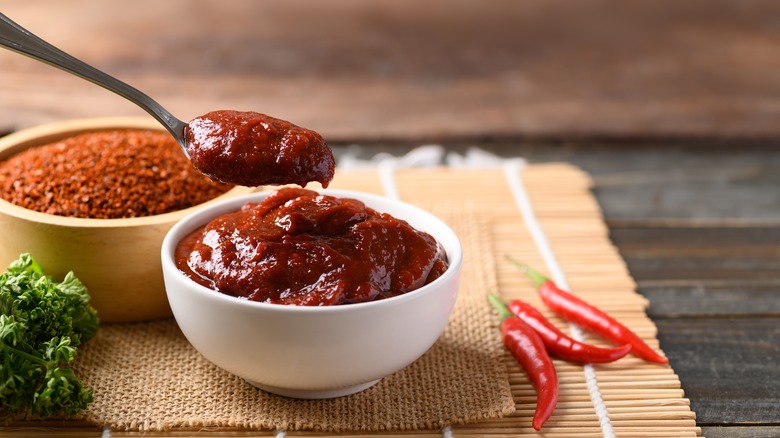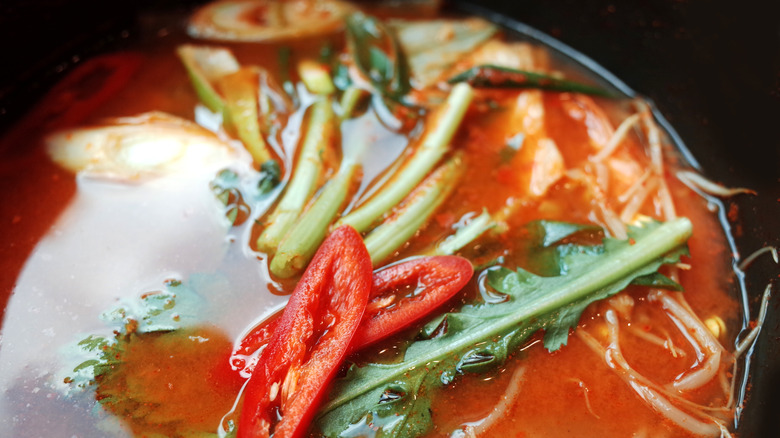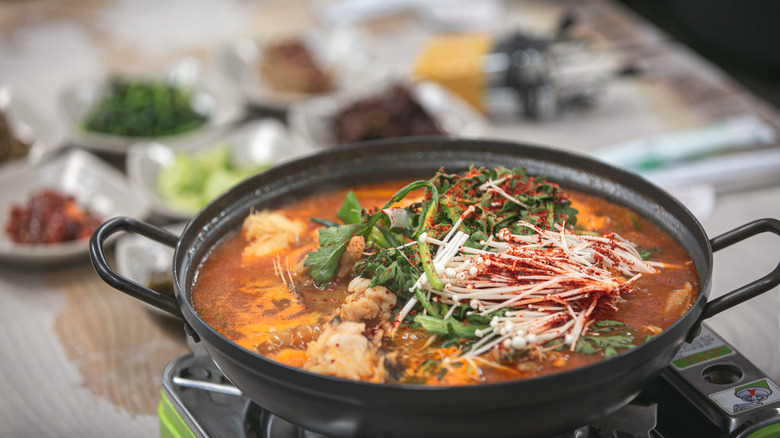Korea's Maeuntang Fish Stew Is Even Better The Next Day
Curry, chili, lasagna — there's a hall of fame for delicious foods that are even better the next day, and it's time to add maeuntang to the roster. This spicy red Korean dish is not a jjigae (stew) or guk (soup), but a special category of soup called "tang." Tang soups tend to have a more watery broth-to-ingredient ratio like guk, but they involve the complexity and the long stewing process of jjigae. Usually, they're based on broth made from boiling bones or flesh, such as the beef bone broth of seolleongtang and gomtang or the pig neck bones of gamjatang. Maeuntang is the most representative of tangs made with seafood, featuring the light and brisk flavor of a white-fleshed fish.
Literally translated to "spicy soup," maeuntang stands with gamjatang as one of the spicier tang soups that pack a punch and aren't for the faint of heart. But unlike the hearty and heavy gamjatang, maeuntang tag-teams with the much lighter flavors of fish to deliver an almost refreshing sort of heat. The mildness of white-fleshed fish also means that, if left overnight, the deceptively mellow yet spicy notes of the broth will marinate into the fish and create an even more complex flavor profile to enjoy the next day. Delicious and refreshing, this spicy fish stew is a must-try comfort food that can be enjoyed year-round.
The history of maeuntang starts with gochujang
While it might be hard to imagine Korean cuisine without gochugaru or gochujang, the fact is that spicy peppers are a relatively recent addition to Korean food as we know it today. Much like many other famously spicy Korean dishes, maeuntang in its current form only dates back to the introduction of chili peppers to the Korean peninsula in the 16th century. Through the Columbian exchange and then via the Portuguese traders stationed in Japan at the time, peppers made their way to the peninsula around the time of the Imjin Invasions. Koreans took to the new spice like fish to water, creating many signature red-tinged and fiery hot dishes such as maeuntang.
While rarely named as "maeuntang" specifically, elaborate fish stews flavored with gochujang pop up in many Joseon-era cookbooks. With so many regional variants, it's hard to pinpoint the exact origins of maeuntang; however, the prevailing theory is that it developed when Koreans began to add gochujang to existing fish stew recipes.
What goes in a maeuntang?
The basic ingredients you'll find in maeuntang are gochujang, gochugaru, any kind of white-fleshed fish, and other seafood and vegetables. The stew is made by boiling the fish alongside onions, garlic, and green onions in an anchovy-based broth before being seasoned with gochujang, doenjang, or a mix of both. Then, additional ingredients such as tofu, radish, mushrooms, and/or shrimp may be added, and the mixture is left to boil and stew the flavors together before serving.
As a versatile dish with many regional varieties, there's really no hard and fast rule as to what should go in a maeuntang, or even which fish you should use. Conventional choices involve the mild and white-fleshed varieties like flounder, fluke, yellow corvina, cod, and red snapper; however, types of maeuntang made with stronger-tasting fish are also popular in certain regions, such as the catfish maeuntang that's a local specialty in Daegu province. Overall, what really matters when choosing a fish for maeuntang is the freshness more than the kind of fish itself.
Eating maeuntang is usually a group activity
If you ever visit Korea, you might find that maeuntang is more often than not offered in group servings. Much like hot pot or KBBQ, maeuntang is usually served in a big pot and shared in a group, with lots of side dishes to offer. Often, there will be noodles or sujebi (chunks of noodle dough) added to the pot early on, turning the meal into a hybrid of kalguksu (another Korean noodle soup dish). Once most of the meal has been eaten and there's nothing left but broth, rice is added to the leftovers and stir-fried into a porridge as a final course.
While this method of eating maeuntang is festive, lively, and satisfying, it's not exclusively for dining out. Despite the complex flavor profile, the process of making maeuntang is surprisingly simple, and it can be very easily made at home for a delicious dinner and even tastier leftovers to keep. The extra-strong flavors of the broth slowly seep into the often milder ingredients overnight, making it taste much richer and more saturated — not unlike how chili and many Korean jjigae taste much better the next day.



